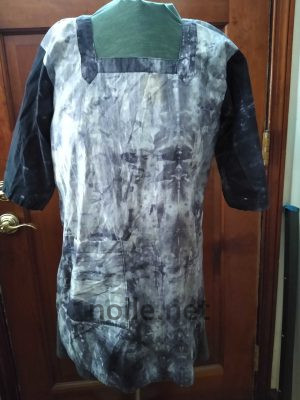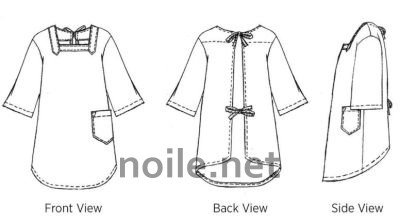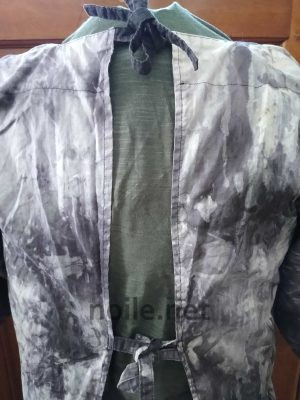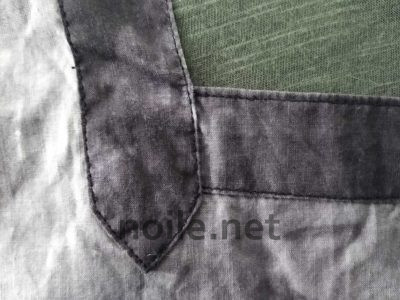I made this apron fifty years ago, for a relative who was beginning to study Ikebana.
Photo of a Japanese-style apron with a square neck
and rectangular sleeves, mid-thigh length, in
a cotton watercolor-effect print in shade of gray.
The sleeves are darker, from the border of the fabric.
It´s held up remarkably well — no abuse, cold water washing, and good quality cotton for the win! This is real sustainability . . . and, since it´s all cotton, if it ever ceases to function as an apron, it should recycle very effectively. No plastic involved.
The fabric was her choice — sort of a smokey watercolor print in shades of gray, with a rather Japanese feeling to it (though I suspect it wasn´t technically Japanese at all). I always thought this was a kappogi — a Japanese kitchen smock or apron designed to keep clothing tidy while preparing food or cleaning.

Line drawing of a ´Kappogi (Mama-san apron)´ showing
sleeves gathered at the wrist, a square neckline with
a decorative edge at center front, and a pocket on lower right.
I think that´s not quite right, though. This article, at Japanesewiki.com, gives an interesting history of the kappogi, which differs from mine in length (it´s knee-length, as described in the article), and the sleeves in a kappogi are elasticised.
Elastic sleeves in a kitchen smock are brilliant, of course — it´s to easy to push sleeves out of the way and keep them there! The illustration above is from round-earth.com, which published a pattern for what they call a ´Kappogi (Mama-san apron´). The pattern may or may not be available; it´s not clear from the website, and, though it´s offered on Amazon, the round earth store there has been inactive for quite a while.

Line drawing from Indygo Junction ´Sixties Smock Apron´
pattern, showing simplified kappogi style with straight sleeves,
back facing, and pocket on lower left.
My version has rectangular sleeves, which are both less full and shorter, and the smock itself is hip-length. The neckline detail is very like that on the round earth pattern, though simpler. I´m quite sure it´s the Indygo Junction ´Sixties Smock Apron´ pattern above. I can´t find the pattern in my scores of boxes, but I know it´s there somewhere!

The back has simple ties; I´d reflexively use webbing these days, but the cotton ties are easy to secure, and equally easy to undo. And they suit the apron far better than anything else would!
It´s now a free download at this site (but I don´t know anything about the site, so buyer — or freebe acquirer — beware) — and possibly elsewhere as a vintage printed pattern, Indygo Junction Model: SP-2429. The original Indygo Junction website doesn´t seem to exist anymore.

At any rate, it´s quite a fine apron/smock, and I´m enjoying noting how much I loved edge-stitching, even way back then — an affection that persists to this day. I´m death on plants, so this smock is now serving, quite nicely, as a watercolor garment while I play with pigments and paper.
*Yep, my smock isn´t ironed. I love the texture of the un-ironed cotton, and this is how I wear it. This isn´t a garment I want pressed into a bland conformity, and it doesn´t need ironing to preserve its shape or its integrity as a utility garment.

I really like this apron. I like aprons in genera, and this one has its own personality. And it is still in use!
I love the longevity! I´m surprised at how practical this apron is. Maybe I need a proper kappogi for kitchen/housework? The elasticized sleeves look so practical.